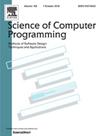利用度量关注进行度量信息挖掘,提高软件缺陷预测性能
IF 1.4
4区 计算机科学
Q3 COMPUTER SCIENCE, SOFTWARE ENGINEERING
引用次数: 0
摘要
在软件工程领域,缺陷预测一直是一个热门的研究方向。目前,传统的软件缺陷预测研究主要集中在度量特征上,度量特征是由各种描述规则派生出来的。许多研究者基于这些度量特征和各种框架模型提出了大量的缺陷预测模型。然而,数据稀缺问题严重阻碍了该领域的发展。因此,本文提出了一种新的方法,即度量关注模块(Metric Attention Module, MAM),该方法挖掘度量数据特征内部、特征之间、模块内以及模块之间的相关性。通过学习新的数据表示,MAM引导模型的学习过程,最终在不改变网络框架结构的情况下提高模型的性能。此外,该方法是可解释的。在这项工作中,在不同的任务环境和不同的数据集上进行了实验,都取得了不同程度的改进。在项目内缺陷预测(WPDP)的背景下,使用MAM数据模型的实验显示,准确率平均提高14.7%,F1评分提高15.9%,AUC提高23.7%,MCC提高65.1%。在跨项目缺陷预测(CPDP)中,在更复杂的任务环境下,该模型跨多个标准数据集表现出优异的性能。与基线模型和训练结果相比,F1、Accuracy和MCC得分分别提高了约40%、20%和50%。本文章由计算机程序翻译,如有差异,请以英文原文为准。
Metric information mining with metric attention to boost software defect prediction performance
In the field of software engineering, defect prediction has always been a popular research direction. Currently, the research on traditional software defect prediction mainly focuses on metric features, which are derived from various descriptive rules. Many researchers have proposed a large number of defect prediction models based on these metric features and various framework models. However, the problem of data scarcity has severely hindered the development of the field. Therefore, this work proposes a new method, namely the Metric Attention Module (MAM), which excavates the correlations within the metric data features, between features, within modules, and between modules. By learning new data representations, MAM guides the model's learning process and ultimately improves the model's performance without changing the network framework structure. Additionally, the method is interpretable.
In this work, experiments were conducted in various task environments and on different datasets, all resulting in varying degrees of improvement. In the context of within-project defect prediction (WPDP), experiments with the MAM data model showed an average improvement of 14.7% in Accuracy, 15.9% in F1 score, 23.7% in AUC, and 65.1% in MCC. In cross-project defect prediction (CPDP), under more complex task environments, the model demonstrated excellent performance across multiple standard datasets. Compared to the baseline models and training results, the F1, Accuracy, and MCC scores improved by approximately 40%, 20%, and 50%, respectively.
求助全文
通过发布文献求助,成功后即可免费获取论文全文。
去求助
来源期刊

Science of Computer Programming
工程技术-计算机:软件工程
CiteScore
3.80
自引率
0.00%
发文量
76
审稿时长
67 days
期刊介绍:
Science of Computer Programming is dedicated to the distribution of research results in the areas of software systems development, use and maintenance, including the software aspects of hardware design.
The journal has a wide scope ranging from the many facets of methodological foundations to the details of technical issues andthe aspects of industrial practice.
The subjects of interest to SCP cover the entire spectrum of methods for the entire life cycle of software systems, including
• Requirements, specification, design, validation, verification, coding, testing, maintenance, metrics and renovation of software;
• Design, implementation and evaluation of programming languages;
• Programming environments, development tools, visualisation and animation;
• Management of the development process;
• Human factors in software, software for social interaction, software for social computing;
• Cyber physical systems, and software for the interaction between the physical and the machine;
• Software aspects of infrastructure services, system administration, and network management.
 求助内容:
求助内容: 应助结果提醒方式:
应助结果提醒方式:


